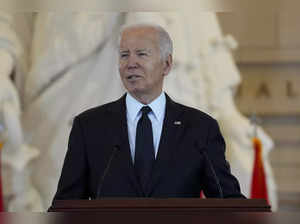 AP
APTaiwan’s booming exports to the US are just one example of the way great-power tensions have already reshaped supply chains — and how China is getting left out of some of them.
The island’s sales to US markets climbed more than 80% in April from a year earlier, hitting a record high, according to data released Friday. In the first four months of 2024, shipments to the US overtook those sent to China, which continued to shrink. Even when Hong Kong is included, China’s share of the island’s trade is dropping.
The Biden administration raised tariffs Tuesday on a range of Chinese products, from computer chips to electric vehicles as part of US efforts to curtail what it describes as Chinese “cheating”. The changes are projected to affect around $18 billion in current annual imports, the White House said.It’s part of a broader trade overhaul for key American allies in Asia, including major economies like South Korea and Japan. Both are seeing a bigger share of exports heading to the US at the expense of China.
Driving the change is a US campaign to cut China out of its supply chains, especially for sensitive and high-end technology products. Investment flows are shifting along with trade, with global firms investing in Southeast Asia to avoid US tariffs on China and companies from Taiwan, Korea and Japan also building factories in the US to take advantage of subsidies for high-tech industry.
“This is a region-wide theme reflecting the trade war and then the investment war,” says Trinh Nguyen, an economist at Natixis. “I think this is going to be accelerating.”
China isn’t losing out completely because its own firms are rapidly boosting investment in Southeast Asia, to avoid tariffs and hold onto their share of supply chains, Nguyen says. What hasn’t changed is that “the US continues to be a key importer of goods in Asia.”

Taiwan’s export orders have long shown that the US is the main source of final demand for its manufactured goods. But the production process often ran via China, where Taiwanese businessmen set up factories in a flurry of investment early this century. Companies would ship components there for assembly, before sending the final product to America or Europe.
The latest numbers show that Taiwan’s exports are starting to bypass the world’s second-largest economy altogether. New Taiwanese investment in China has also fallen dramatically, to just $3 billion last year from a peak of $14.6 billion in 2010, even as firms based on the island invested record amounts elsewhere.
All of this illustrates how global supply chains are rearranging themselves in the aftermath of the pandemic and the trade war that began under US President Donald Trump.
Not everything has panned out how Trump and others might have expected when the first tariffs were slapped on Chinese imports back in 2018. For one thing, China-based firms are part of the investment rush toward other regional countries like Vietnam, whose exports to the US more than doubled during the trade war.
“The tariffs are effective in the sense that it managed to reduce direct imports from China, but ineffective in the sense that they still find their way to the US,” says Henry Gao, a law professor at Singapore Management University, who researches Chinese trade policy.
Still, he says, if the ultimate goal was “near-shoring or friend-shoring — ie forcing the relocation of production facilities from China to countries more friendly with the US — then the strategy is working.”











 Get Unlimited Access to The Economic Times
Get Unlimited Access to The Economic Times
